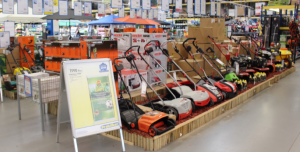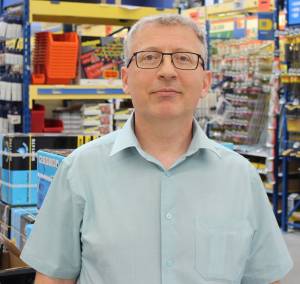 FEATURE – When Praktiker decided to turn to lean thinking, they were faced with the challenge of rolling out its principles and practices to 20 DIY stores. Here’s how they are trying to make it work.
FEATURE – When Praktiker decided to turn to lean thinking, they were faced with the challenge of rolling out its principles and practices to 20 DIY stores. Here’s how they are trying to make it work.
Words: Béla Sólyom, Strategic Project Leader, Praktiker Hungary
Lean roll-outs are often frowned upon. Many say they are doomed to fail as the responsibility of bringing change about typically lies with a Lean Team that travels across plants (or branches or offices or stores) carrying a “recipe for success” that one can copy and paste. I agree that there isn’t much to this approach, and that’s why at Praktiker – a chain of 20 DIY stores across Hungary – we are trying to do things a little bit differently.
Praktiker was established in Hungary in 1998, but it is a very different company today than it used to be. After a decade of fast growth, the 2008 crisis hit, eventually leading our German mother company to go bankrupt. The various satellite organizations in different countries were sold. Praktiker Hungary was bought by Wallis Asset Management in 2016, and that’s when we really started to write a new chapter in our story. The vision of the new owners was to develop Praktiker through strategic projects. More importantly, our focus moved to improving the way we serve customers in our stores – for that, lean thinking seemed like the obvious way forward.
Our first steps were in our store in Gyor, with the support of LEI Hungary. We worked there for six months, running a series of workshops for our store managers and department managers and encouraging people to solve concrete business problems at the gemba (capability development is our core focus). Before long, we had seven improvement projects running in parallel. When they were completed, local leaders presented the results to top management, who was impressed and decided that lean should be brought to all Praktiker stores.
To do that, we had to organize a roll-out in waves, the first of which involved a group of four stores and lasted from October 2017 to February 2018. We worked with them for 16 weeks, visiting each store four times with the entire group (which proved great to help knowledge transfer from one location to another). We organized gemba walks at the stores and helped them close in on and tackle their specific problems. When leaders of the four stores presented the results in April, management reiterated the need to go down the lean route. We have now started our second wave, and plan to reach all stores by August 2019.
We learned pretty quickly that if you want to achieve real change, you need to transform the organizational culture rather than simply improve processes: with that in mind, we increased our focus on capability development at store and department management level. This also reflects our decision to avoid putting the lean transformation in the hands of a team of “lean experts” and focus on developing everybody’s capabilities instead (in particular, we wanted managers to feel responsible).
THE CHALLENGES OF A ROLL-OUT
A copy-and-paste approach is a real risk in any roll-out. Even though there is an expectation from management that an improvement achieved in one Praktiker store should be pursued in the other stores as well, we are also aware of the fact that each store is unique. Our locations are similar, but not the same – they each have their own layout, hardware, size and customers – making copy-and-paste a particularly dangerous exercise.
We try to ensure that people develop an understanding of the context of the specific store before they try to make an improvement or implement a change that proved successful elsewhere. It’s not easy to find the narrow path leading to success, and that’s one of the many reasons why changing mindset is a first critical step. (Top management is now accepting that store differences must be taken into consideration.)
We need people to think about each situation critically and to understand why a change is necessary. We don’t put too much emphasis on what problems to solve first. Instead, we leave it to the department and store managers to decide what problems to tackle next. It’s good to see they are picking the real painful processes rather than the easy-to-fix issues – to us, this is proof of how giving people responsibility motivates them.
We are realizing that without strong leadership support, a roll-out has not hope of succeeding. We are trying to involve regional managers (we have two, one for western Hungary and one for eastern Hungary), so that they too can support the lean transformation in our 20 stores. In our minds, their primary role is to help local managers and front-line staff sustain standards and mentoring. But before any of that can happen, they need to develop their own problem-solving capabilities – something we are addressing by taking them to gemba where improvements are already stable and by coaching them. We are also setting up management systems to sustain improvements and keep developing new standards.
The role of top management is also fundamental in ensuring the problem solving continues after the workshops. Our General Manager has now realized the potential of lean thinking and has begun to walk the gemba in all stores, communicating how important lean is to Praktiker. The impact this is having on our staff is huge, and it will help a lot when we eventually establish a clearer link between improvement at store level and strategic goals of the organization (something we have begun to do by focusing first on customer-facing processes).
SOME OF OUR IMPROVEMENTS
We have introduced a lot of changes as a result of our lean efforts. To increase the sale of tiles in one of our stores, for example, we made it much easier for customers to select the tiles they wanted, find them and pick them up by themselves. Not only is that real value for them; the more self-serving customers we have, the more time our salespeople can spend with clients who need their help. We have also done a lot to improve our replenishment process and ensure there are no empty spots on the shelves and no missing products: low-runners, therefore, were moved to the higher shelves, while high-runners were placed next to the sample walls, where customers can easily see them and pick them up. A pull system was also installed to prevent stock-outs from happening.
One of the most successful experiments we ran involved processing product changes and refunds (Praktiker gives customers the chance to return products within 30 days). In our Budapest M3 store, this activity used to take a very long time and represented a clear struggle (a situation made worse by the lack of a Praktiker-wide standard on returns). The store staff, supported by deputy store manager Zsolt Móczik, started to analyze the current state. In particular, they measured the number of returns and started to look into their causes: it turned out there were 8,700 returns executed in the store in one year, of a total value of Ft 110 million (€ 345,000), and that 6,100 of those products were in perfect condition. This meant they were returned simply because people had changed their minds – quite a common occurrence. This was really frustrating, because the only determination that had to be made before approving or denying the return for this kind of products was whether the customer had used or damaged the item. The process, instead, was much more complex.
Before we introduced lean, whenever a customer asked to return a product, the Information Desk employee could choose to call three different people to ask whether or not they should proceed with the return: the Store Manager, the Supervisor of the cash desk area or, 97.5% of the time, a salesperson from the area the product came from. The average time they had to wait for a salesperson to arrive was 10 minutes in this process, the total time for serving a customer ranging between 1 minute and 40 minutes. Salespeople were spending a whopping 51 days a year dealing with refunds and returns. That’s all time they could not spend selling!
We realized that people were asking for help – thus lengthening the refund process – because their colleagues from the relevant department knew the products, and they didn’t. So, we gave them all the information they needed to make a decision and established clear standards they could follow (product control now happens in three parts: are all parts there? Is the product damaged? Was the product used?). Using the TWI approach, we created product cards for the most important items we sell, showing the steps to follow to check a product before making a decision on a return (for products over Ft 20,000, approval from the store manager must be obtained). There are several tricks we taught people: for example, a good way to see whether a customer has already used a tap is to unscrew and check that no drops of water come out.
We gave our people the tools they needed in order to become autonomous in their decision-making, and as a result the number of times the department salespeople were called dropped by 75%. It was empowerment at its best: once they were given the information, people went from not wanting to take responsibility to being confident decision-makers. Waiting time for customers at the Information Desk now ranges between three and five minutes, and it never exceeds 15 minutes.
Even though, because of its nature, this solution is not store-specific and can be rolled out to the other 19 stores without any need for adaptation, it’s a good example of how we are trying to spread lean across our network: by creating clear standards that help us to tackle business problems and by making life easier for our employees.
THE AUTHOR
Béla Sólyom is Strategic Project Leader at Praktiker Hungary.
